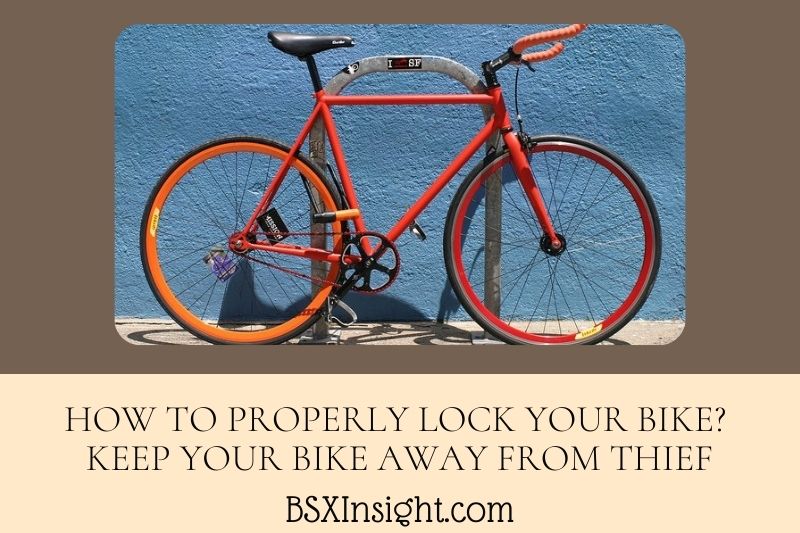There are a few different ways that you can lock your bike, depending on what type of lock you have. If you have a chain lock, you can loop it around the frame of your bike and then secure it with a padlock. If you have a U-Lock, you can thread it through the wheels and frame of your bike and then secure it with a key.
Either way, it’s important to make sure that your bike is locked up properly so that it doesn’t get stolen.
Keep reading our article to get more useful information about how to lock a bike.
How To Lock Your Bike?
Part 1: Securing Your Bicycle On The Street
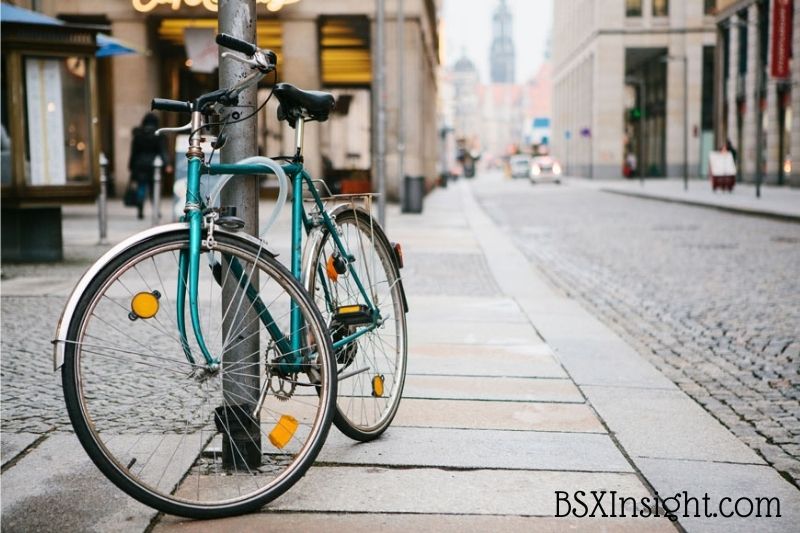
A street bike that is improperly fastened will vanish very soon. Fortunately, you may significantly reduce this likelihood by carefully considering where and how you lock your bike on the street.
Where Can You Lock Your Bike On The Street?
Although your neighborhood’s characteristics will impact this, there are some broad guidelines you should always aim to follow.
Tip 1: Pick a crowded location
Try to pick an area where there are lots of people strolling by. Better still, if CCTV adequately covers the area. Thieves are put on edge by other individuals and CCTV. They would much instead remain unnoticed while they “work.”
Pick a location where several other bikes are already chained up there. Ideally, in the middle, rather than at the end, of a line of motorcycles. This accomplishes three things:
First, bikes will inevitably not be appropriately locked, making them more appealing to thieves than your secure bike. Second, a burglar has less room to move around and properly use their tools when many motorcycles are packed together.
Thirdly, other cyclists may bother them with their arrivals and departures, and if anyone is going to confront a bike thief (and let’s face it, most people just pass by), it will be other cyclists.
Tip 2: Choose an immovable object
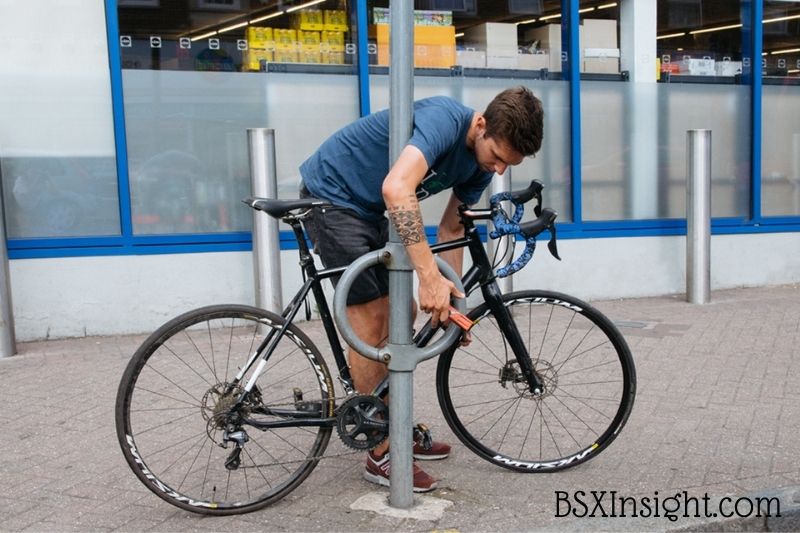
A bike’s security depends on what it is locked to. Therefore, always select a fixed, immovable object that is not vulnerable to damage.
Verify that nothing you’ve attached the bike to can be lifted over it. Or that the item is difficult to disassemble or unscrew. Steer clear of trees, scaffolding, aluminum or wooden poles, signposts, and chain-link fences.
If you decide on metal railings, work the lock around as many of them as possible. However, the ultimate immovable item would be a custom-made bike rack anchored into the ground.
But even with these, you need to exercise caution! When bike racks are vacant, some crafty thieves break through them, concealing the cut with tape to conceal their crime.
The robber returns after the unaware biker have locked their bike to the rack, pry open the cut part, and steals their bike! Therefore, ensure that whatever rack you utilize hasn’t been tampered with.
Tip 3: Don’t provide thieves with hints.
Consider securing your bike a few streets away if you plan to spend a lot of time away from it, such as at the movies, the recreation center, or any other location.
Why? A thief will know they have plenty of time to work on your bike if they witness you locking it and entering one of these locations.
Tip 4: Take extra precautions
Avoid a harmful area if you are aware of it. If you really cannot avoid it, bring a backup lock. Also, don’t leave your bike unattended for too long!
Where to lock your bike on the street is summarized as follows:
- Select a busy location with CCTV
- Lock your bicycle amid many other bicycles.
- Always lock your bicycle to a stationary, unmoving item, preferably a bike rack.
- Don’t lock your bike outside locations where you’ll be spending a lot of time.
- Take an additional lock if you know the area’s high theft risk.
Best Way To Lock A Bike on The Street
This will change depending on your bike type, the lock you use, and the location where you secure it. But there are several recommendations you should always abide by…
Tip 1: Lock your frame.
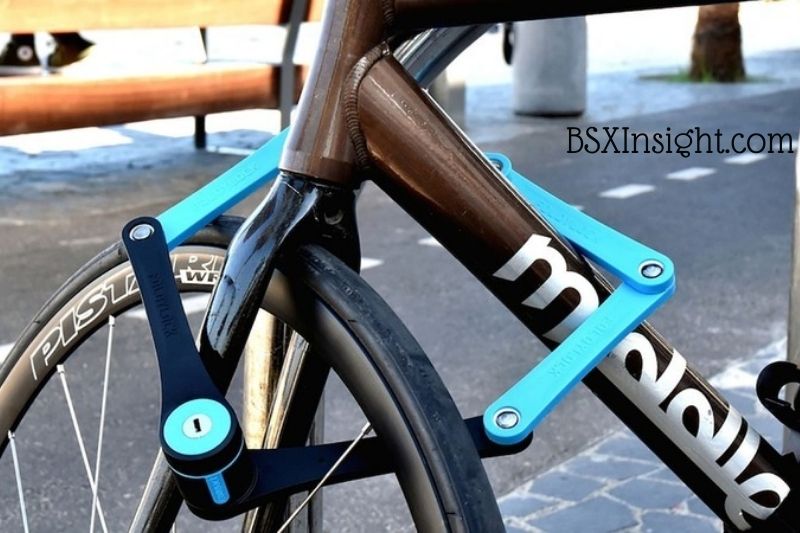
Locking your frame to an immovable object is a must. A burglar will quickly remove your wheel and ride off with the remainder of the bike if you merely lock your bike through the wheel.
Although it may seem obvious, it happens frequently.
Tip 2: Keep your lock off the ground.
Keep trying to keep the lock off the ground. If it’s on the ground, a burglar can smash the lock with a hammer and destroy less expensive versions if it hits the hard floor.
But stay away from the top tube as well. A burglar can try to break the lock by lifting and twisting the entire bike if the lock is around the bicycle’s top tube.
Alternately, insert a length of metal that can be used to twist and pop the lock open because there may be more room inside the lock while it is on the top tube.
Therefore, the lock should ideally be placed high up around the down tube or seat tube.
Tip 3: Make the lock challenging to open.
Make the lock as challenging to open as you can. It will be challenging to assault if it is tough to access.
And even better, you can set it up, so the keyhole faces down. This will make tampering with the locking mechanism more challenging.
The keyhole may be blocked by thieves using superglue, requiring you to leave your bike unlocked overnight and giving them more opportunity to steal it during the day when traffic is lighter.
Or, some burglars could be able to pick your lock without using force. However, these attack methods become more challenging if the keyhole is difficult to access.
Tip 4: Fill the inside of a U-lock
If you’re using a u-lock, attempt to fit the bike and whatever it’s linked to within as much of the U as possible. This is quite significant…
Leverage attacks are the most popular method for breaking the better u-locks. The U-shaped opening is filled with a length of metal or scaffolding pole, which is then twisted until it pops open.
Attacks using hydraulic bottle jacks are less frequent and rely on enough room inside the u-lock for the instrument to be inserted.
However, a thief cannot use either of these strategies if there is no extra room within the U. Keep those locks closed!
Here is a quick guide on locking your bike to the pavement:
Always secure the frame to a specific object—not simply the wheel!
Lock away from the ground as much as possible, but stay away from locking the top tube.
If you employ a u-lock, occupy as much of the inside space as possible to make the lock as challenging to open as feasible.
Four Street Bike Locking Techniques
Here are four tried-and-true methods for locking your bike to the ground using those general pointers. Which one is ideal for you will depend on the cost of your bike and the type of locks you have.
- Using two locks to secure your bike

Using two locks to secure your bike is a proper bike locking technique. And ideally to an in-ground bike rack that is anchored.
The first lock should be wrapped around the bike rack, the frame, and the back wheel. The second one should wrap over the bike rack, the front wheel, and the frame.
This indicates that the frame is fastened in two locations and that the bike rack and both wheels are fastened to the frame.
Some people advise using two distinct lock types since doing so forces a burglar to carry two different lock-cracking tools.
I like to use a chain lock and a u-lock together. My bicycle is left on the sidewalk all night. And I leave a strong chain lock permanently fastened to the bike rack, so I don’t have to bring it around every night as I lock it in the same spot.
I only use the U-lock during the day. But I can always bring the chain lock with me if I’m traveling someplace risky or where it might be left overnight.
However, it’s important to note that if you decide to leave a large lock-in public area, there’s a chance that a would-be thief will use it to hone his skills.
Even worse, if a thief has already identified your bike, he might disable the large lock while you’re away, leaving you with little choice but to use the smaller lock when you come back. He will then seize on your weak security after that. So take care!
I should point out that in the picture up top, the chain is way too loose and could be positioned so that it was vulnerable to bolt cutters if it were to get so close to the ground!
- Using a cable and a single lock to secure your bicycle

Another relatively common method is to utilize a cable and one good lock. Around the rear wheel, the frame, and the bike rack, fasten a u-lock or chain as described before.
After that, slide one loop through the other loop on the cable, secure the first loop to the primary lock, and put the other end through the front wheel.
The fact that the cable is so light makes this procedure advantageous. So, compared to utilizing two good locks, you’re saving significant weight.
The only thing holding the front wheel in place with this method is the cable, which is a problem. Additionally, as I’ve already indicated, cables offer no natural protection because they can all be cut through in a matter of seconds.
Why not secure it with some string? Additionally, it might be a nuisance to weave the cable through the bike in a small, congested space. Additionally, although light, they are large and complicated to carry around.
However, many believe the cable’s visible and psychological barrier is sufficient. And this can be the situation if your bike has inexpensive wheels that don’t employ fast-release skewers.
However, I don’t like this approach and would never use it for quick-release wheels.
- Locking your bicycle with a single lock and the front wheel off.
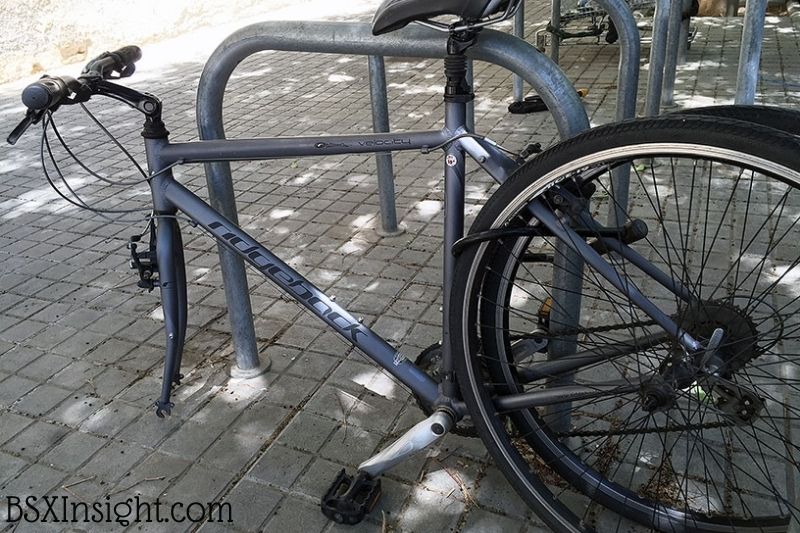
Around the back wheel, the frame, and the bike rack, secure the u-lock or chain as described above. However, you have also taken off the front forks in the area around the front wheel.
This ensures that one strong lock is used to attach the frame’s wheels. A u-lock will be fuller and less vulnerable to a leverage or bottle jack attack if you use one.
But keep in mind that this technique requires a standard-sized or larger u-lock. And it would be difficult to use a chain in place of it.
Quick-release wheels are required for this technique. Therefore you’ll have to use them everywhere to stop the wheel from being stolen.
The following two methods make an effort to address the issue of how to lock the front wheel when there is only one lock available.
This is especially crucial if you have quick-release wheels, which enable you to rapidly remove your wheels without needing tools (or anyone else who wants to take them!).
Quick-release wheels and saddles are a hassle for me and not worth the trouble. How frequently do you have to take your wheels off?
Using secure skewers or regular nuts is preferable to replace the fast-release mechanism. This makes it considerably more difficult to steal your wheels and, in some situations, eliminates the need for a second lock.
- Using the “Sheldon” method to lock your bicycle

The renowned cycling expert Sheldon Brown recommended placing a u-lock within the frame’s rear triangle to lock only the rear wheel to the bike rack.
He argued that employing this technique may prevent the wheel from being pushed through the rear triangle without securing the frame to the bike rack.
This method allows you to utilize a smaller, lighter u-lock because you are simply locking the wheel. For several excellent examples, visit my page on the best lightweight bike locks!
I’m not sure about this method, especially for more expensive bikes. With some work, a determined burglar might remove the lock by sawing through the back wheel.
I can also see an opportunistic burglar trying to steal your bike and doing serious harm to it since they didn’t realize it was adequately secured.
I believe this method is suitable for brief periods if, for whatever reason, you cannot maneuver your bike into a position where you can lock the frame.
Part 2. Locking Your Bike At Home
It’s essential to keep in mind that while street theft receives most of the media attention, more than 50% of stolen bikes are taken from the owner’s residence. That includes coming from the front or back yard, a shed or garage on the property, or even inside the actual house or apartment.
How do you stop this from happening? You may still do many things to safeguard your bike, even though home protection for bikes is frequently more challenging than street security.
Let’s take a closer look at each of these rooms in the house.
Keeping Your Bicycle Inside of Your Residence
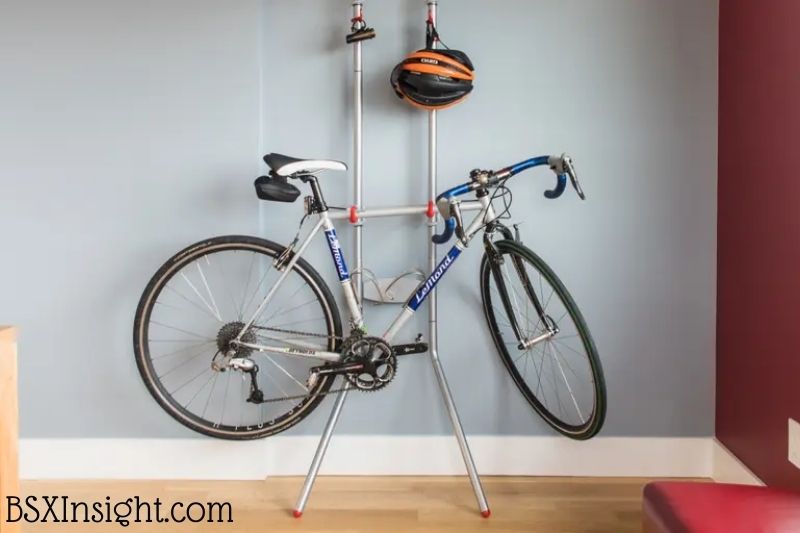
The safest place to store your bike is unquestionably within your home or apartment. However, a lot of people are unable or reluctant to allow bicycles into their homes.
Perhaps they (or, more frequently, other family members!) don’t enjoy the thought of large, filthy machinery taking up space in their house. They might not enjoy the inconvenience of bringing a bike indoors. Or perhaps there isn’t enough room.
Numerous businesses now provide inside-the-home storage options for bikes if space is an issue.
These devices come in a wide range of designs and costs. But in the end, they’re all just things you hang your bike from and attach to the wall or ceiling.
Although the modern motorcycles in the advertisements appear fantastic, they are never covered in the three months’ worth of London street filth.
The safest place to store your bike is inside your home, provided you can put it there and there are no issues with it.
Keeping Your Bike In Communal Spaces
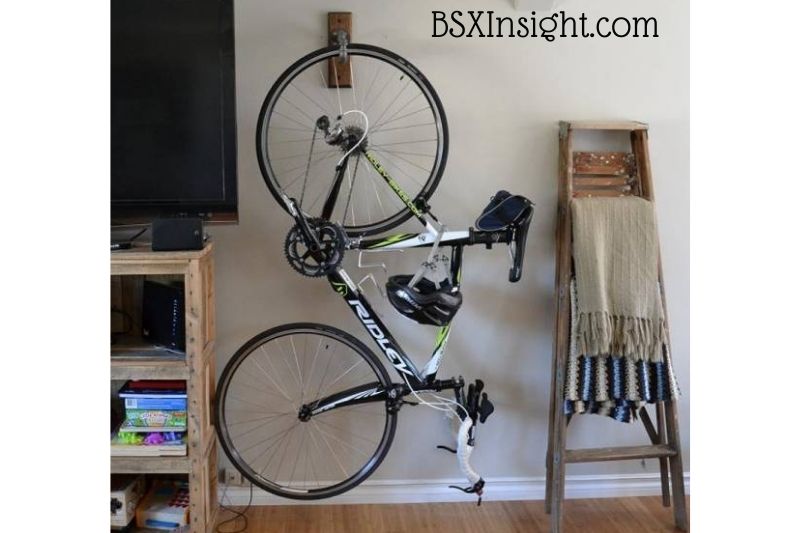
It can be tempting to keep your bike in a common social area if you live in an apartment with one (often in the hallway, just inside the front door). However, storing anything in this location is extremely risky.
Since it’s not your place, there is typically nothing to lock your bike to and little room to mount anything.
The result is that your unprotected bike lies in the hallway waiting for someone to forget to lock or close the door, at which point another person will enter and take it.
One thing is sure, though: nobody else in the building is considering how to keep your bike secure.
Filling a sizable bucket with cement and setting a ground anchor or an old u-lock in the wet cement are two do-it-yourself options. You now have a relatively substantial anchor that you may use to keep your bike in place in the corridor.
To make the bucket less intrusive to the other building occupants, my buddy placed some plastic flowers on top of it.
Theoretically, this won’t actually stop a determined thief; it will simply slow him down. But in practice, it will thwart the majority of chancers.
Keeping Your Bike In A Shed or Garage
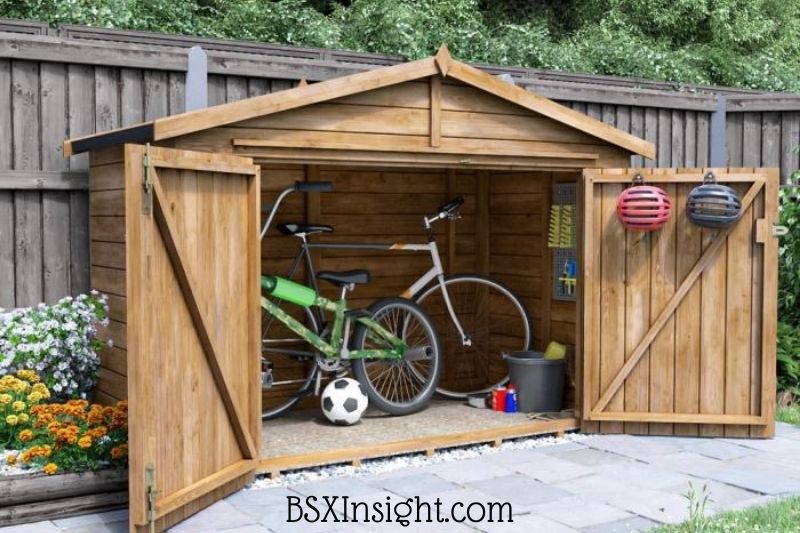
If you’re fortunate, your home may have a garage, or a bike shed. This is the next safest option if you can’t keep your bike inside your home.
Generally speaking, garages are safer than sheds. Even if it’s on your bike stand and you’re still working on it, you should never, ever leave your bike unlocked in either one.
No matter how safe it seems, your bike is most at risk because more than half of all stolen motorcycles are taken from their owners’ homes.
However, finding something suitable to tie your bike to in a garage or shed can be challenging.
Bikes in garages
The advantages of brick walls and concrete floors are found in garages. Due to this, installing a ground anchor that you may use to attach your bike with a heavy chain is comparatively simple.
Similar to locks, anchors come in a wide range of prices and security levels. Fortunately, Sold Secure and ART have rated them as well, making it rather simple to choose a solid one.
I’ve prepared a thorough guide to picking and installing a decent ground or wall anchor to assist you in finding one, and because they will probably make the most impact on your security setup, you may use it to find one.
Ground anchors work well with chain locks and can typically be fastened to a garage’s floor or walls.
Purchase the thickest chain you can manage because you won’t have to worry about lugging these chains around. However, be cautious that the chain won’t be too thick to pass through the shackle of the anchor of your choice!
Bikes in sheds
Since wooden sheds typically don’t have concrete flooring, installing a standard ground anchor can be challenging.
A part of the floor may be torn out, a hole dug into the ground below, filled with concrete, and an anchor like the Oxford Terra Force added to set in the wet concrete. However, this would need a lot of work and might not even be feasible.
Fortunately, Pragmasis now sells a “shed shackle” specially made to provide reliable means of locking your bike in metal, wood, or other storage sheds. I believe these are fantastic.
They are functional, affordable, and simple to install. Additionally, if you combine one with a strong chain, a burglar would essentially have to destroy your shed in order to steal your bike.
You can do many things to increase your shed’s security. You range from low-tech improvements like sealing the windows to more high-tech ones like adding a shed alarm.
For many helpful suggestions, see my advice for improving the security of your shed!
Keeping Your Bike In The Garden or Yard
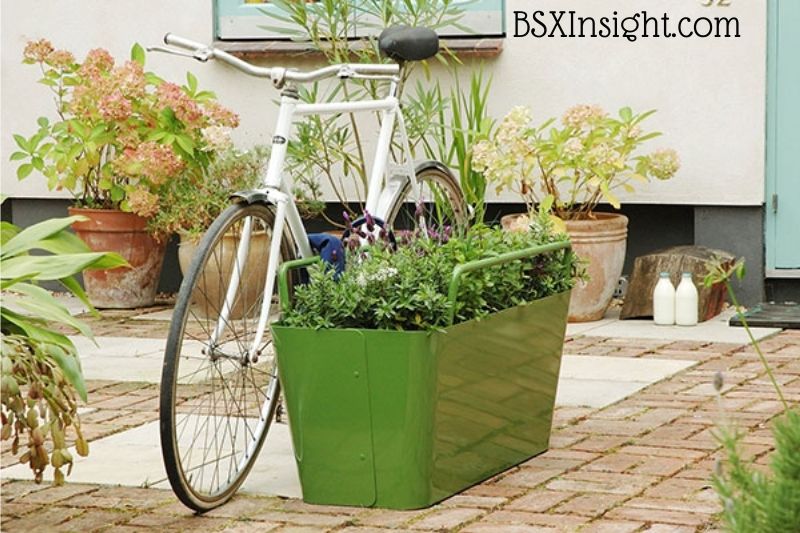
Consider purchasing a bike storage unit if you don’t have a garage or a shed but have room in your garden or yard. Asgard produces the best (and most expensive) products.
You’ll have just to store your bike underneath a bike cover if there isn’t enough room for a storage container. If you can place a ground anchor in your garden in this situation, do so.
Perhaps there is a concrete slab to which an anchor can be attached. Alternatively, you may create a hole in the ground, fill it with wet concrete, and add an Oxford Terra Force to make it hard. Alternately, you might apply the bucket trick I advise for public areas.
A PlantLock is an elegant alternative that, unlike the other choices, takes no installation and will genuinely make your outside space greener and more beautiful.
These enormous (90 x 40 x 52 cm) steel troughs can be used to grow various flowers, herbs, and plants. And you can lock a bike to the 19 mm thick, boron steel handles on either side. In all, two bikes can be secured by each PlantLock.
It will weigh around 75 kg after the PlantLock is filled with soil and plants (or much more after rain or watering), making it an “immovable item”. Additionally, the base has holes so that you may bolt it to the ground for added security.
The 19 mm handles are case hardened to withstand sawing, tempered to fend off any brute force attack, and impossible to bolt crop. The only tool that can circumvent the PlantLock is an angle grinder. However, a thief will actually target your bike lock instead!
No matter the approach you select, it’s crucial to never leave your bike unattended in your garden, no matter how secluded or out of the way it may seem. If you do, eventually, someone will steal your bike.
Part 3. Locking Your Bike At Work
Nowadays, many places of employment provide secure areas where commuters can keep their bikes. This is excellent news!
Of course, the amount of security will differ between these locations. The most crucial thing to remember is to lock your bike as securely as you would if you were parking it on the street if someone other than you had access to the area.
It doesn’t matter how small or uninviting your office is or how safe it feels. There is a real possibility that it will eventually be compromised if other people access it.
I can’t remember how many times bikes were taken from office lockups that appeared impregnable while I was a resident of London.
Types of Bike Lock
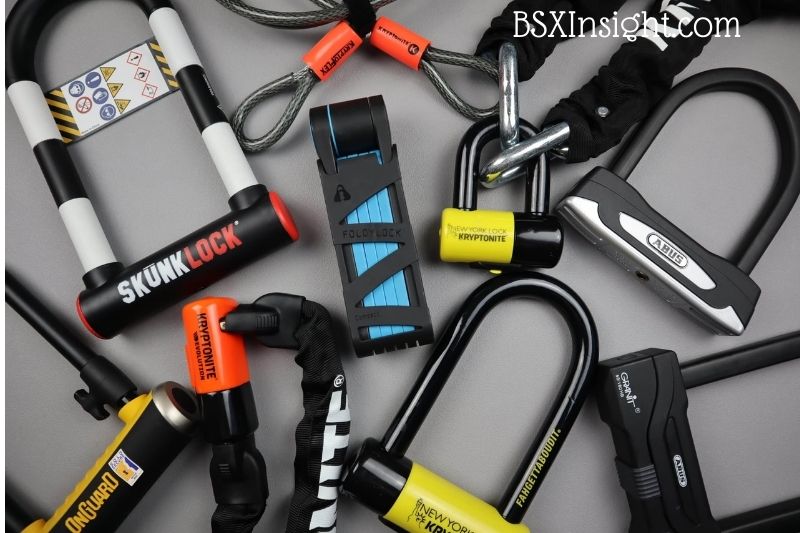
What Type of Lock Do You Need?
There are many different lock types available. Each has advantages and disadvantages based on your needs, your budget, the level of security needed, where you want to lock your bike, and how portable the lock needs to be.
You should consider your bike’s value while selecting a lock. Due to its high potential for resale, either as a whole or in its parts, the expensive bike may be more desirable to thieves than a less expensive model.
If you’re serious about bike security, you should aim to spend at least 10% of the worth of your bike on a lock. A quality lock shouldn’t be an afterthought when you buy a bike.
Another critical factor is weight. Even though many D-locks include mounts so you may attach them to your bike, a strong lock will be cumbersome to carry about.
If you frequently travel the same route, you might wish to invest in a solid yet heavy lock that you can store.
Keys or combination dials can be used to secure locks. Even locks may be opened with a smartphone app. Although combination locks can also be made secure, keys are typically required for more secure locks.
Sold Secure Ratings
When purchasing a bike lock, it is highly recommended that you look for a Sold Secure rating. Independent tests are conducted on Sold Secure locks to determine how easy they may be opened.
Locks are rated by Sold Secure on a gold, silver, and bronze scale. Gold Sold Secure lock will be the most secure but expensive; a bronze lock may deter an opportunist but not a professional thief, and a silver lock will frequently compromise security and cost.
The terms of your bike insurance may stipulate that you use a lock with a Sold Secure rating to verify your coverage.
Types of Locks and How To Use Them
Unfortunately, experienced bike thieves can eventually pick just about any lock, or they can damage your bike in the process.
However, if you pick the right lock and know how to use it, your bike will be far less likely to become a target.
Lightweight Cafe Locks
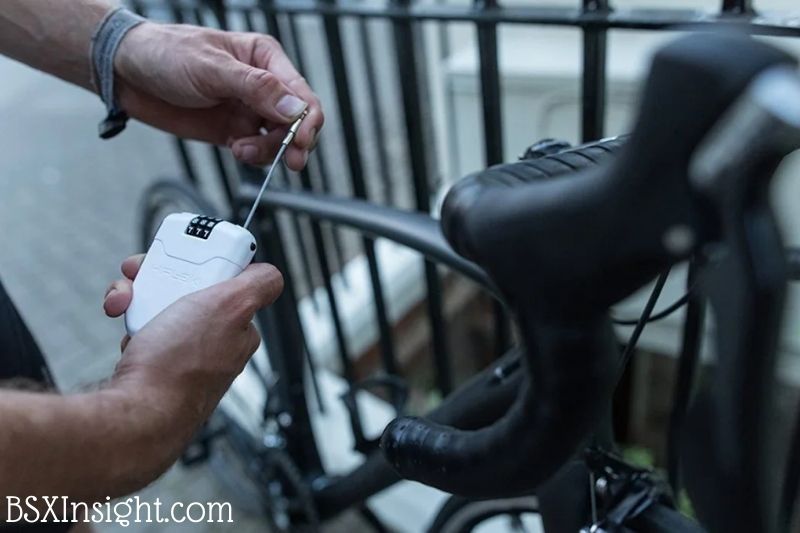
Let’s get right to the beginning. A lightweight café lock’s benefit is, as its name implies, its low weight. This makes it simple to transport while riding, either in luggage or, more likely, in a pocket.
On the other hand, the level of protection you receive is relatively low. A lightweight lock is typically straightforward to open, sometimes even without using tools or just an essential pair of wire cutters.
Therefore, using a light lock is only an option if you want to immobilize your bike somewhere, like a coffee shop, and you and other people are likely to keep an eye on it most of the time.
Instead of leaving your bike propped up outside the cafe, lock the frame to a sturdy object with a thin cable to prevent someone from simply strolling away with it.
Be advised, though: a lock like this should only be utilized for the most fundamental level of bike security. You’ll need a more secure lock if you want to leave your bike unattended for any length of time or in a location where there is a reasonable chance of theft.
Fortunately, you have a lot of choices.
D-locks
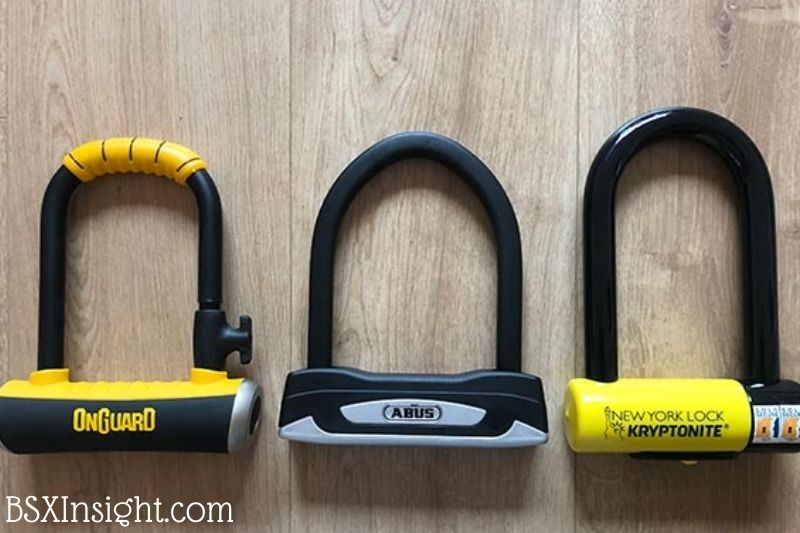
Cycling enthusiasts use D-locks because they find a compromise between portability and weight. D-locks are also known as U-locks. When not in use, a D-lock can be fastened to your bike and offers a fair amount of protection without adding too much weight.
When it comes to D-locks, there are numerous options. Most locks can deter criminals from acting on impulse but opt for a lock with the Sold Secure rating for increased security.
To defend against leverage attacks, keep your lock above the ground and fill the shackle as much as possible. In this aspect, a D-lock with a shorter shackle will be beneficial, albeit it might be more challenging to lock your bike.
A high level of security can be achieved by using two high-quality D-locks, one to secure the front wheel and frame and the other to secure the rear wheel and frame.
Chains
Chains The strongest chain locks typically have links that have been strengthened.
A cloth sleeve is frequently wrapped over a chain lock to protect your frame (most D-locks are coated in plastic for the same reason).
Although a chain lock has the flexibility benefit, carrying one around might be difficult and hefty. Look for a motorbike chain (Sold Secure offers a single tier for motorcycle items, gold) for the highest level of bike security.
Also available are folding locks with joints. Although the joints need to be strengthened, they are lighter and easier to handle.
Cable locks
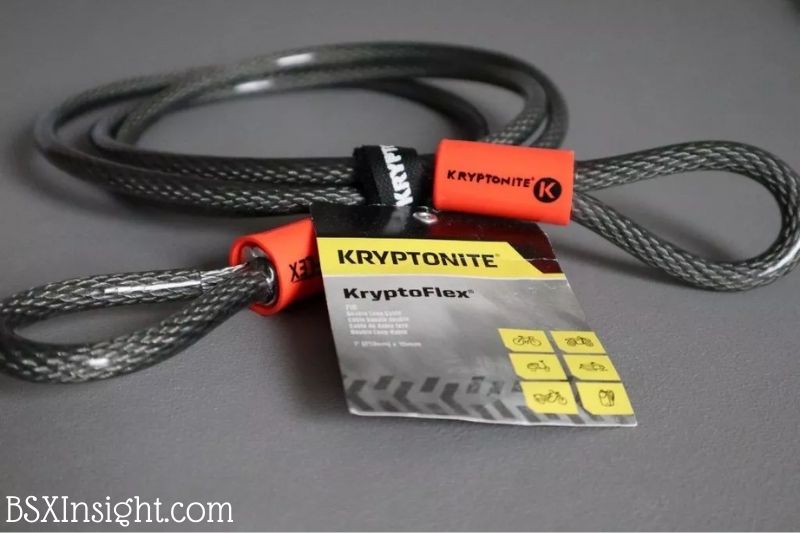
A typical cable lock is an additional choice. A cable lock can be a helpful complement to a more secure lock, even if it is unlikely to be as secure on its own as a chain or D-lock.
A D-lock or a different padlock must be used with some cables, some of which have their locking mechanisms, while others have loops at either end and are made to be used with either of these locks.
One standard method for securing the frame and wheels at both ends of the bike without carrying two heavy-duty locks is to use a cable lock in conjunction with a D-lock.
To secure your bike (or its parts) in high-risk regions, a cable lock can be used, but keep in mind that it is attackable and should only be used as a deterrent.
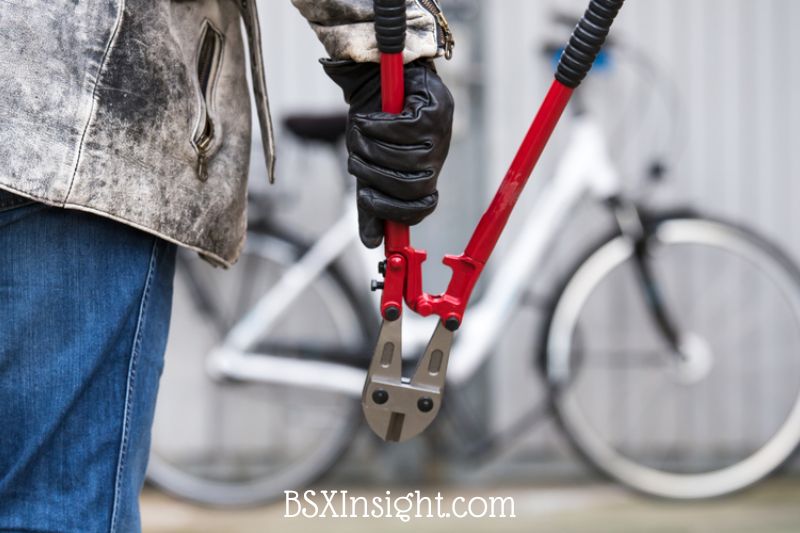
Reasons Why You Would Need to Cut Your Bike Lock
There are a variety of situations where you would need to cut a lock, aside from illegal and criminal ones. You need to return home but are unable to open the lock; in this situation, you will need to know how to cut bike locks. You might need to know these steps for the following reasons, among others:
1. You Lost Your Keys
Bike riders frequently drop or misplace their keys after locking their bikes, which is one of the main reasons they search for ways to cut locks. It would be challenging to go back and look for the key.
If you frequently misplace your keys and it has occurred to you frequently in the past, it is preferable to learn how to pick a lock than to waste time looking for them or call a professional locksmith to do it for you.
2. The Lock Has Been Modified
A tampered lock? What do you mean by that? The lock is claimed to be tampered with when children attempt to insert sticks into a bike’s lock or when crooks attempt to unlock a bike but are unsuccessful.
You’ll have trouble unlocking the bike lock and won’t be able to use keys in a tampered lock hole. Because a broken lock won’t open easily, you’ll need to know how to cut or unlock your bike.
3. Bolt Lock Failure
The lock may occasionally appear to be in fine shape, but it still won’t open when you use keys or enter a secret combination of numbers or characters. When a bolt lock malfunctions, there may be a problem with the lock’s internal mechanism.
The bolt lock failure occurs when the lock’s internal mechanism breaks down and the lock is unable to be opened. The age of the lock itself is the most frequent cause of this failure.
How To Cut A Bike Lock
Learning how to cut a bike lock cable is a useful talent to have, especially in emergency situations where a cyclist is unable to unlock the lock for some reason. However, this skill shouldn’t be utilized for any unlawful activities.
Only in extreme cases may locks be broken or cut. Without the right equipment, you run the danger of breaking the instrument and possibly hurting yourself. The preferred tool for cutting a bike lock open is a bolt cutter.
However, there are several techniques you can use to cut and shatter a lock in order to unlock your bike.
1. Using only your hands
You don’t need to be the Incredible Hulk to pick a lock; you can simply pick many locks with just your bare hands. For instance, if your bicycle becomes stuck to the bike rack or fastened to a pole, you can easily break the cable locks.
2. Cable or Wire Cutters
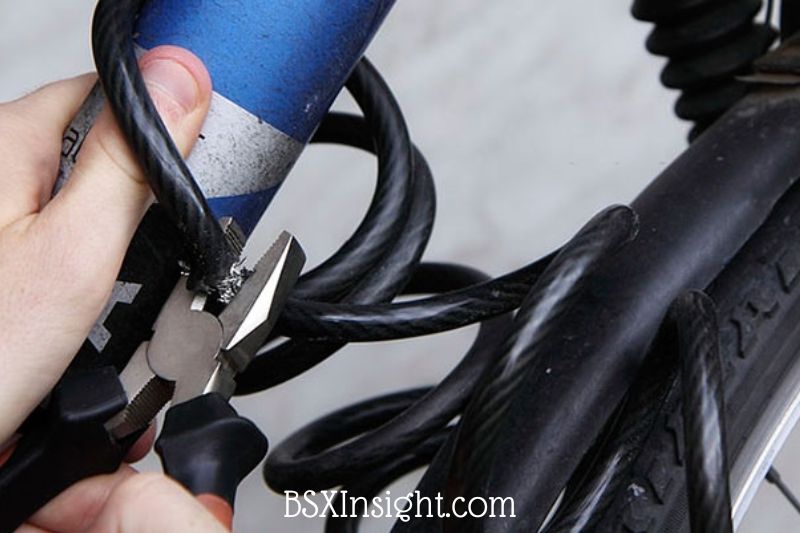
If you want a quick and simple solution to this issue, you may release your bike by cutting through most cable locks with a cable cutter. This tactic is discrete, simple, and inexpensive, and you can simply carry this tool around in your coat pocket; bike thieves primarily employ these tools.
3. Hacksaws
If you don’t have cable cutters, you can easily cut a cable lock with a hacksaw. When you ride bikes with your companion, keep one in your purse. Even soft and thin metal U-locks can be hacked with a hacksaw.
4. Hammers
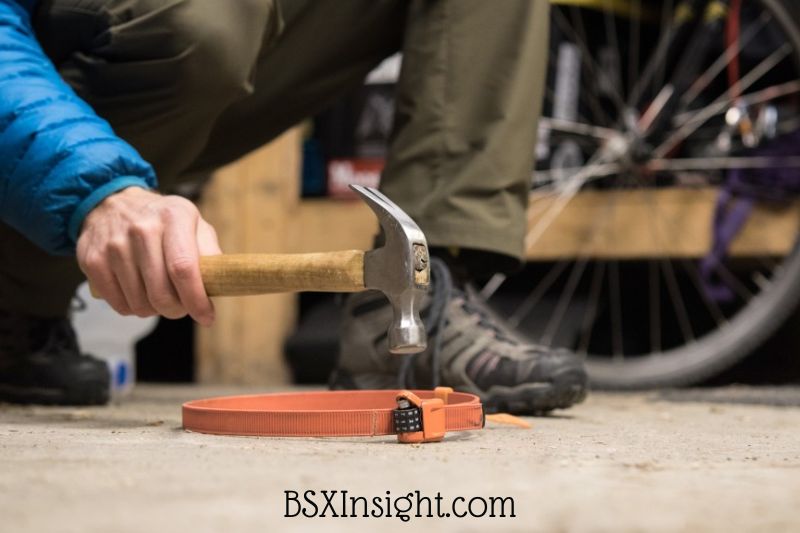
If you have a poor-quality lock, even a common household item like a hammer can be used to break the bike lock.
This is risky, though, as a burglar can quickly take your priceless bike by striking the lock system while keeping it leaning against a concrete sidewalk. Therefore, if you want to keep your bike as secure as possible, adopting a reliable locking system is crucial.
5. Scaffolding poles and crowbars
The most secure method of locking your bike is using a U-lock, which is also the trickiest to cut if your keys are lost or someone tampers with them.
In this situation, crowbars, scaffold poles, and lengthy metal parts are employed to unlock your bike. They function well with mid-range U-locks.
6. Bolt Cutters
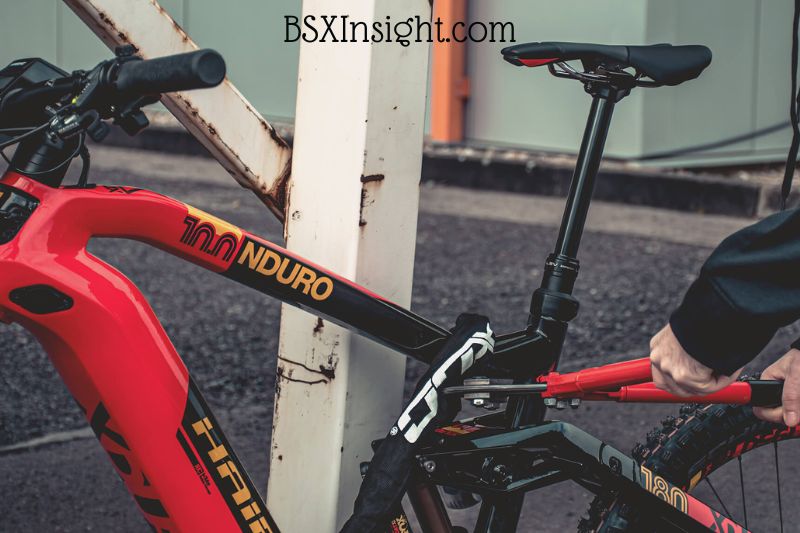
Bolt cutters are the best and quickest way to cut the toughest U-locks and thickest chains.
They come in different sizes; you can easily carry one about in a backpack and use a smaller one to cut cable locks, while thieves use a medium-sized bolt cutter to cut chains and U-locks.
Bolt cutters are the most common tools used by bike thieves to pick locks and steal parked bikes easily.
7. Bottle Jacks with hydraulics
Although it’s not a very popular gadget, a hydraulic bottle jack can be purchased if you frequently misplace your keys. The way this approach operates is by getting inside a U-lock.
Even the most secure locks can be opened by applying extra pressure to the lock. Thieves unlock locks and steal motorcycles using this technique.
8. Portable Angle Grinders
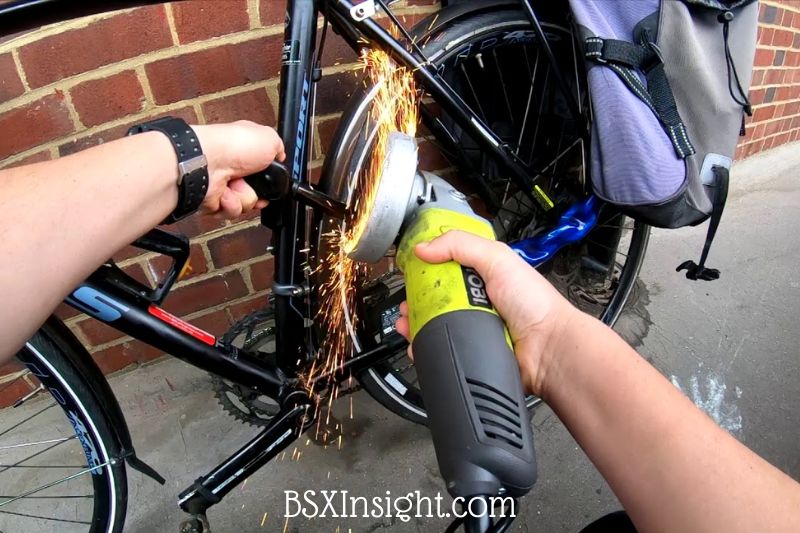
Because battery-powered angle grinders make a lot of sparks and noise, people are more likely to notice them. Angle grinders can readily cut through any lock, although it takes more effort to open thicker locks.
How to Unlock a Bike Locked with a U-Lock?
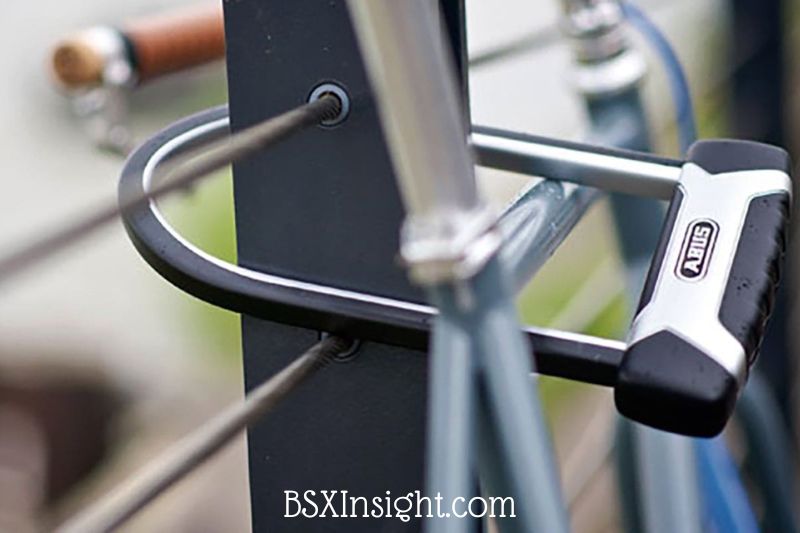
The easiest approach to keep your bike secure in a dangerous place is to lock it with a U-lock in the bike rack. However, these locks can also be the most challenging for you to open if you forget or drop your key while using them.
But fear not; in addition to cutting locks, there are a number of techniques to pry open a U-lock and release your bike.
1. Using a ballpoint pen to open a U-lock
You can use a plastic pen or the easy ballpoint pen trick to unlock a bike lock. To unlock the bike lock, insert the hollow cylinder into the keyway after removing the pen’s tip or using a tube with a similar diameter.
This approach works best if you are returning to the parked bike after losing your key, but it won’t entirely work if the lock has been tampered with.
Then you would have to unlock your bike without damaging the lock using one of the ways indicated above to cut locks, or you could hire an expert.
2. Cracking cheap locks Shims usage
Poorly constructed and low-quality locks can be shimmied open. Shimming the lock is a relatively common technique that only needs a few thin pieces of metal in the shape of sailor hats.
By inserting the pointed end of the shim into the gap between the lock body and the shackle, you can open the bike lock.
To retract the locking pawl, place the shim inside the shackle’s U-shape and press it down.
3. Call a locksmith
It is crucial to contact a locksmith if none of the aforementioned techniques worked to unlock the bike lock. They would be able to cut through or break through any type of lock.
Many bike owners attempt to complete this process on their own and neglect to contact a locksmith. However, locksmiths with their expertise can quickly open cheap bike locks without compromising the lock’s construction, restoring the locks’ functionality.
A locksmith may be able to service more expensive locks that offer great security in addition to opening it so you can utilize it once more. A locksmith might be able to repair your lock by replacing the damaged core, creating a new key, discovering your combination, etc.
Choose the correct locksmith to unlock your bike; this will prevent you from looking for do-it-yourself techniques to cut through locks and allow you to hire a professional to handle the task for you. A specialist would know precisely how to assist you in reducing a lot of your tension.
Let rid of your ego and know that if your bike is stuck at home or at a parked bike rack, you may call a locksmith. Choosing a professional to complete the work you lacked the time to learn how to perform yourself is perfectly acceptable.
How to Pick a Good Bike Lock
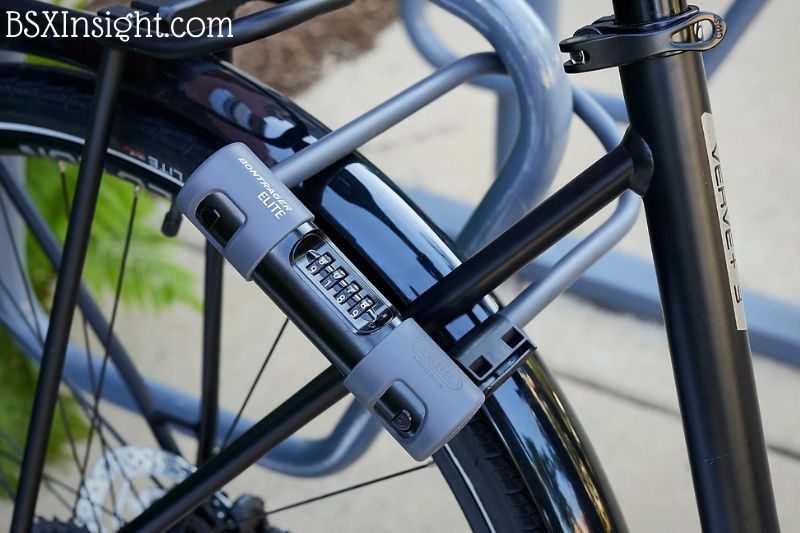
Selecting the appropriate lock is the first step in securing your bike. Depending on your needs, there are a number of excellent solutions available.
A pink wire combination lock, the thickness of a drinking straw, served as my childhood bike lock. I eventually concluded that a pair of primary school scissors could be used to cut it in two. (Also, the combination might be deduced by the audible clicking sound of the correct numbers.)
These locks are primarily symbolic actions. Although flexible cable locks are simple and effective for locking challenging structures, they frequently fall into the category of being “easy to breach.” In Amsterdam, I observed a cunning man use a pair of bolt cutters to cut my much-sturdier cable lock casually.
A cable lock should only be used as a wheel lock or secondary security if you live in a city and wish to cling onto your bicycle, not your primary lock. They are simply too simple to snip, and if the barrier to stealing it is so quickly breached, even a cheap bicycle may be an appealing alternative for criminals.
The picture of a tiny U-lock in the back pocket or belt loop has become symbolic of bike messengers and fixie culture since U-locks are the most popular lock option for urban riders. They are portable, sturdy, and relatively light in weight.
However, a U-rigidity lock and form restrict what you can lock to, which is why many riders choose cables or chains instead. High-security U-locks come in various sizes, from small and portable to those that can hold both your tire and frame, all from ABUS. Read also about How To Ride A Bike
A wonderful, albeit heavy, choice is a highly thick chain with a powerful locking mechanism. Although it makes you appear suspicious, it is versatile and highly efficient, provided you don’t mind the added weight.
In addition to the typical U-lock, chain, and cable categories, there are a few other lock types to consider. The folding lock, developed by ABUS and later copied by a few other companies, combines a chain’s flexibility with a U-lock’s security. They are also incredibly portable and lightweight, rapidly making them a favorite among urban and recreational bikers.
Along with the expansion of the upright bike market, frame locks, which have long been popular in Scandinavian nations, are slowly gaining popularity in North America. However, in most North American cities, they should only be viewed as a secondary security measure.
Component locks, a method for locking bicycle parts like your saddle and wheels, are also becoming increasingly well-liked. If your city bike currently has a quick-release mechanism, which thieves like to target because it makes your components very easy to take, these are fantastic solutions.
In order to deter would-be thieves, ABUS provides an intelligent component lock called NutFix that secures both the wheels and the seat post.
A Few Other Things To Consider
Register Your Bike
The police provide this service for free. If you often lock your bike publicly, you should register it and get it security marked.
Snap Pictures of Your Bike.
Take pictures of your bike so you may share them with the authorities and on social media if it is stolen, increasing your chances of recovering it.
Additionally, for added peace of mind, it is worthwhile to ensure your bicycle.
Protect Your Components
Consider purchasing locking nuts for the wheels, Seatpost, and other parts of your bike if it will be left locked up in public settings for an extended period.
Even if the frame is secure, it is simple for a burglar to unscrew and remove the sections.
FAQs
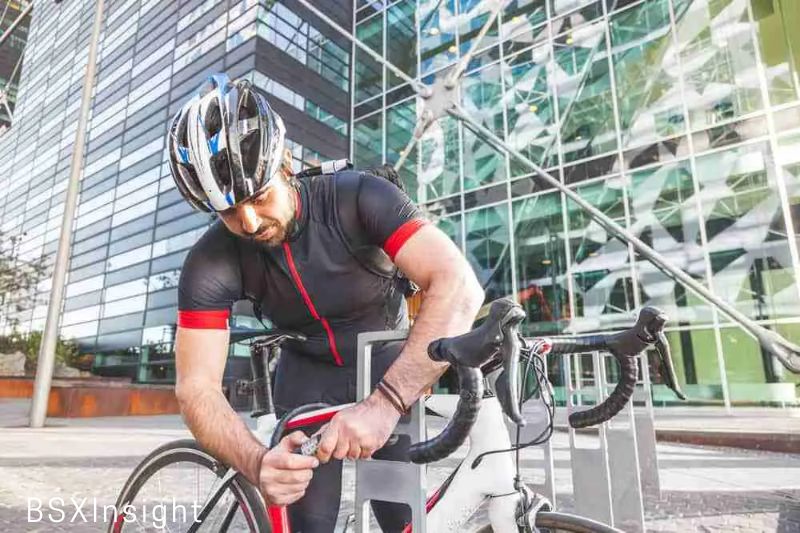
What is Kryptonite Level 5 14 mm U-Lock Bicycle Lock with Looped Bike Security Cable?
You can purchase a thick (20mm) cable lock that is somewhat harder to cut, but the best course of action is to use cable locks as an additional thief deterrent, not stand-alone security. X Research sourceable locks can also be used to secure less valuable bike attachments to the frame, such as a basket.
What is Kryptonite 8mm Chain Key Chain Bicycle Lock and Kryptonite 12.7mm U-Lock Bicycle Lock?
Thieves may use social riding apps to watch where a rider with an expensive bike starts and ends their rides to pinpoint the location of where the bike is stored.
D-locks (sometimes referred to as U-locks) are popular with cyclists because they strike a balance between portability and weight. A D-lock can be mounted to your bike when not in use and provides a good level of protection without weighing you down too much.
Conclusion
The general consensus is that the more components you secure, the better, and you should abide by this. You can deter criminals from targeting your bike by locking up as many of its parts and accessories.
If you don’t also lock your bike with a high-quality lock, robbers will target your bike and probably steal it. Visit the reviews section at the bottom of the website to read some of mine. I thoroughly examined the top bike locks in each category.
When your bike is locked up, keep your lock off the ground and fill the locking space to protect against hydraulic attacks.
There are a number of bike locks that are unbreakable. However, every bike lock may be broken with enough time and the appropriate equipment.
You could choose to enroll in a bicycle insurance plan to safeguard your investment further if your bicycle is pricey or if you want a little more peace of mind.
Lock it or lose it, as always.

